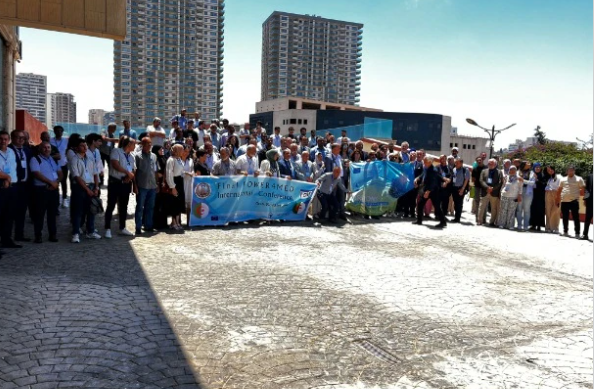Since the 1970s, the region of Gabès, in eastern Tunisia, has lived under the fumes of a massive phosphate processing complex — a mineral used in the production of agricultural fertilizers. Denouncing its severe environmental and health impacts, local residents are now calling for the dismantling of the site.
“The People Want the Dismantling of the Factories!”
Several thousand people have been demonstrating since Saturday, October 11, in Gabès, on Tunisia’s eastern coast, demanding the closure of a massive phosphate processing complex. These factories, established in 1972 and operated by the Tunisian Chemical Group (GCT), are accused of poisoning the soil, the water, and the region’s inhabitants.
Public anger erupted the day before, when images shared on social media showed middle school students collapsing, carried away by firefighters wearing oxygen masks. It was the latest in a long series of incidents: since September 9, at least 310 people have been hospitalized for breathing difficulties, likely caused by toxic gas exposure, according to figures from local NGOs.
Although no official explanation has been provided by the authorities, all fingers point to the same culprit: the GCT factories.
“It’s deadly poison,” exclaimed Ikram Aiouia, a 40-year-old housewife whose son has been hospitalized three times in two months. “I felt burning in my throat,” her son recalled. “My head was heavy, and I lost consciousness.”
A Phosphate Capital
A port city on Tunisia’s eastern coast, Gabès could have been a paradise. Located at the gateway to the desert and just a few kilometers from the Mediterranean Sea, it is home to a 7,000-hectare oasis — the only maritime oasis in the world. Until the 1960s, the city enjoyed lush vegetation, abundant fishing, and thriving tourism.
But its face changed in the 1970s when Tunisian authorities decided to turn it into the phosphate capital. This black mineral, essential for fertilizer production, is one of Tunisia’s main natural resources. For the past fifty years, phosphate has been extracted in the Gafsa mining basin in the west, then transported by train or truck to the Gulf of Gabès, where it is washed and processed. Sulfuric acid and ammonia are then added to produce phosphoric acid, which is loaded onto large cargo ships bound for countries around the world — including France.
This highly profitable business for Tunisia — accounting for 1.7% of GDP in 2020 — comes at a severe environmental cost. Producing phosphoric acid requires vast amounts of water: seven to eight cubic meters per ton, the equivalent of roughly fifty bathtubs, according to a 2018 European Commission report. This process has steadily depleted the oasis’s natural water sources.
Millions of Tons of Waste Dumped into the Sea Each Year
In addition to excessive water use, phosphate processing produces particularly toxic waste. The European Commission report notes that producing one ton of phosphoric acid generates five tons of waste, consisting of sludge saturated with heavy metals and naturally radioactive elements.
“These residues, known as phosphogypsum, are directly discharged into the Mediterranean Sea,” warns Moaz Elbey, a Tunisian journalist who has conducted several investigations on the topic. “The quantities are astronomical. Between 10,000 and 15,000 tons of waste are dumped every day — around five million tons per year.” Over the years, the beaches surrounding GCT’s plants have turned into mud fields, and the sea has taken on a mercury-like color, between brown and gray.
In January 2023, the investigative outlet Vakita analyzed the heavy metal content of waste from Gabès and compared it with Canadian regulatory limits. The results were alarming. On Chatt Essalem Beach, the region’s main shoreline, cadmium levels — one of the most carcinogenic heavy metals — were nearly 900 times higher than Canada’s maximum permissible threshold. The samples also contained zinc (85 times higher) and arsenic (112 times above the limit).
The result has been catastrophic for marine biodiversity. “We’ve lost 93% of our biodiversity since the 1970s,” reported the local NGO Stop Pollution to France Info in 2023. “Only 7% of algae species remain, and the number of fish species has dropped from 300 to fewer than 20.”
A Surge in Respiratory Illnesses
Adding to the disaster are the toxic fumes of sulfur and ammonia billowing from the factories’ chimneys, notes journalist Moaz Elbey.
According to the European Commission’s 2018 study, 95% of Gabès’ air pollution comes from the gaseous emissions of these plants, which contain fine particles, sulfur oxides, ammonia, and hydrogen fluoride.
“Since then, data from the National Environmental Protection Agency consistently show concentrations exceeding the World Health Organization’s air quality limits,” Elbey continued. “And while no official document has assessed the health impact on residents, several independent studies have shown a high prevalence of serious illnesses — particularly respiratory diseases — in the city.”
In the streets of Gabès, testimonies abound. “We’ve had enough — this has to stop. My three children and I have asthma. My husband and my mother died of cancer because of this chemical group,” said Lamia Ben Mohamed, a 52-year-old protester, to AFP.
An Aging Industrial Complex
Faced with this grim record, NGOs and protesters are now pointing to another major issue: the dilapidated state of the infrastructure, which is worsening the situation.
For Ahmed Guefrech, a local official, there is no doubt: the recent waves of poisoning are due to “old equipment” leaking toxic gases. According to him — also an environmental activist — the emissions are caused by “aging polluting units,” “deteriorated machinery,” and poor maintenance, compounded by “production levels that exceed what the site can safely handle.”
In response to public outrage, President Kaïs Saïed announced last Saturday that a joint team from the Ministries of Industry and Environment would be dispatched to “take the necessary measures.” But many experts remain skeptical about the possibility of cleaning up a complex inaugurated 53 years ago.
Authorities had already promised in 2017 to dismantle the complex — which employs around 4,000 people — and replace it with facilities that meet international standards. That promise, however, has never been fulfilled.
“The people’s demand is very clear today: they want the 2017 promise to be honored and these polluting factories dismantled,” stressed Khayreddine Debaya, a member of the Stop Pollution movement, in an interview with France 24. “These factories are a threat to the inhabitants and to the entire Gabès region.”
A State Caught Between Health and Economics
The Tunisian state now finds itself in a difficult position, as phosphate mining remains a “fundamental pillar” of the national economy, according to President Kaïs Saïed. Authorities have even pledged to quintuple fertilizer production by 2030 — from around 3 million tons per year to 14 million — to capitalize on rising global prices.
For Gabès residents, the next step may unfold in court. A group of local lawyers representing poisoned students has announced plans to file a lawsuit against the GCT.
Source: france24



